.gif)
After using the ROG Phone 8 as our daily driver for four weeks, we share our thoughts and experiences with the revamped Gaming Phone from ASUS.
 |
| ROG Phone 8's all-new redesign |
To recap, the ROG Phone 8 carries a 165Hz Samsung E6 LTPO AMOLED screen, the 4nm Snapdragon 8 Gen 3 octa-core processor, New Adreno GPU, LPPDR5X RAM, UFS 4.0, and a 5,500mAh battery with 65W fast charging and 15W wireless charging.
At the back are the 50MP main camera, a 13MP ultra-wide camera and a 32MP 3x telephoto camera with OIS and an LED flash.
Other key features include WiFi 7, Bluetooth 5.3, IP68 water and dust resistance, Air Triggers, and ROG Vision display.
Aside from the dramatic design change, our favorite new features like wireless charging and IP68 water and dust resistance are now included.
In the Philippines, the ROG Phone 8 starts at PHP 50,999 for the 12GB/25GB model.
Let's dive into the review!
Multimedia Experience
 |
| ROG Phone 8's symmetrical screen with slim bezels |
In front is the 6.78-inch Samsung E6 LTPO AMOLED screen with a 2,400 x 1,080 resolution, a 165Hz max refresh rate, a 2,500 nits peak brightness, and HDR10 support. It is protected by Gorilla Glass Victus 2.
Around the panel are super slim side and top bezels. The chin bezel is slightly thicker than the rest. This is a dramatic change from the slim side bezels with thicker top and chin bezels which accommodate the older front-facing speaker design. On the top bezel is the hidden super slim earpiece that serves as the second speaker.
At 2,500 peak brightness, the screen is bright enough to be readable outdoors under direct sunlight. The images produced are vibrant, high contrasty, and detailed.
It supports 10-points of multi-touch which makes it great for multitasking or games that support multiple simultaneous touch inputs. It responds instantaneously and accurately to our taps and gestures.
At the back of the Phone is the new AniMe Vision display which are programmable mini-LED lights with 341 LEDs that can showcase animations or personal customizations. It can be useful by displaying notification numbers and charging levels.
 |
| Top and bottom |
For audio, the phone is equipped with dual stereo speakers and multiple microphones. The second set of speakers is found at the bottom. ASUS has decided to reduce the bezels of the screen to a minimum which bumped the speakers to new locations.
The power and volume of the speakers are about 90 percent of the previous set-up but we prefer this as there is more screen while having a sleeker physical body. Sound quality is nearly the same with barely any distortion even at maximum volume. It is still one of the most immersive audio we've tried on a phone. Albeit slightly less than the previous generation.
On-device audio is still one of the main strengths of the ROG Phone 8.
The microphones do a good job of picking up sounds from a meter away while the noise-cancellation for calls is good too.
Cameras
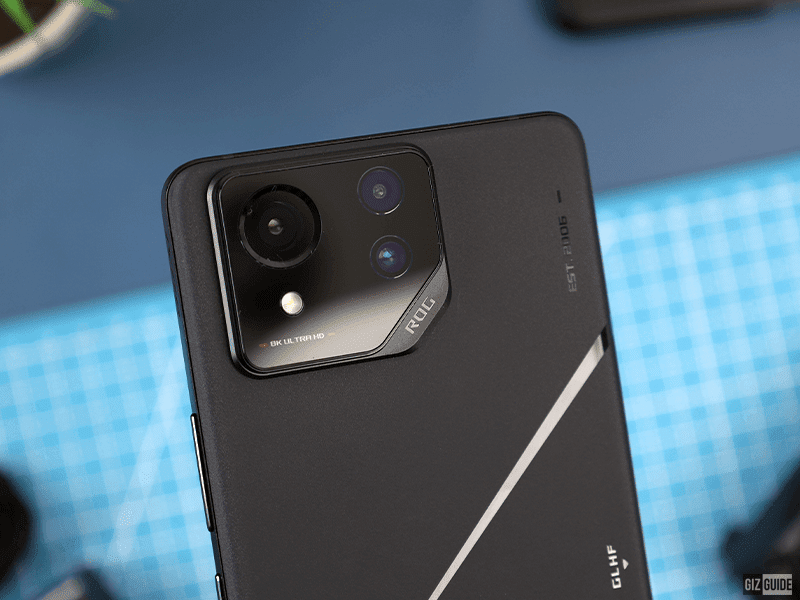 |
| ROG Phone 8's rear cameras |
As mentioned earlier, the phone is equipped with a 50MP f/1.9 main camera with Sony IMX890 1/1.56-inch sensor with OIS, a 13MP f/2.2 120-degree ultra-wide camera, and a 32MP f/2.4 3x telephoto camera with OIS and an LED flash.
Better cameras versus other gaming phones!
The stock camera app's modes include Photo, Video, Portrait, Pro, Night, Pro Video, Light trail, Pano, Time-lapse, and Slo-Mo.
The Pro mode allows for controls of ISO (25-3200), Shutter Speed (26-1/10,000 sec), EV (+-2), Focus, and White Balance. It allows switching between the 1x, 3x, and ultra-wide too.
Rear Camera Samples
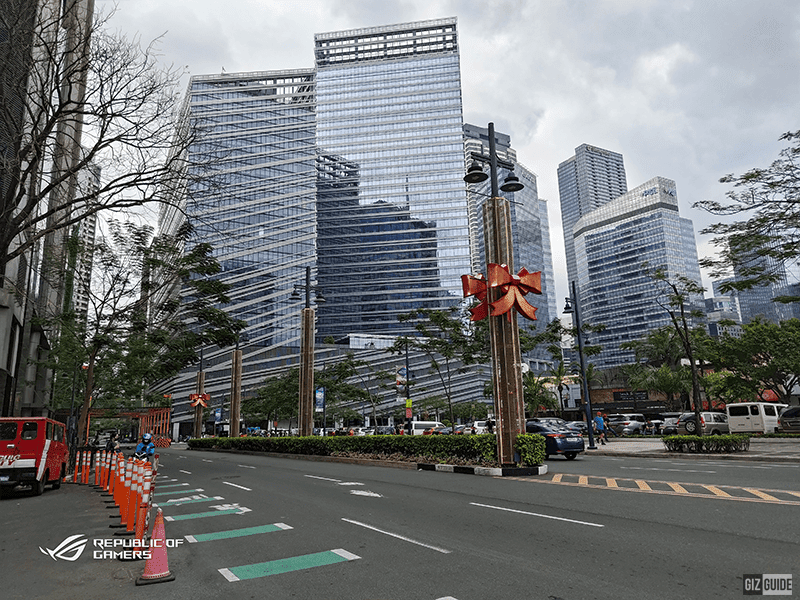 |
| Rear Camera daylight 1x |
 |
| Rear Camera daylight 2x |
 |
| Rear Camera daylight 3x |
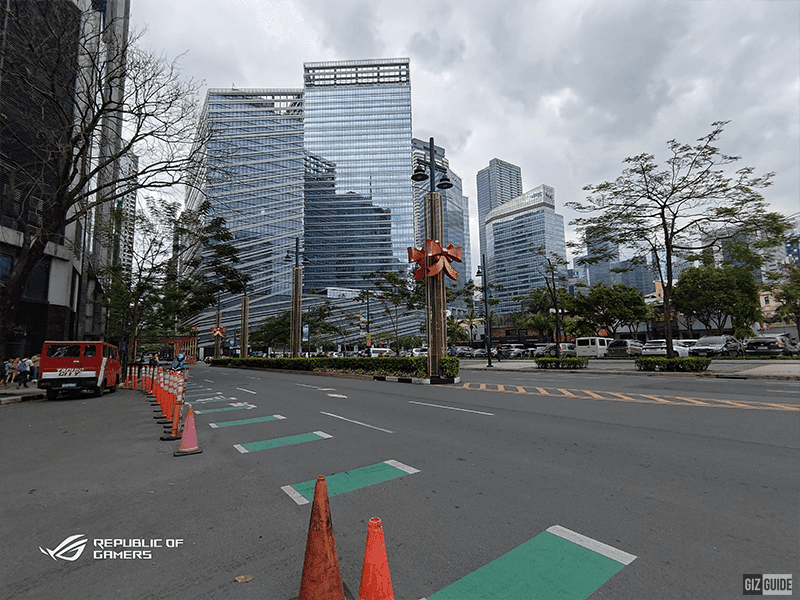 |
| Rear Camera daylight ultra-wide |
All daylight images from the rear camera module produce surprisingly similar results in terms of color and contrast. The color is vibrant and the contrast is deep. All three images are detailed and sharp but we've seen sharper images in the same price range.
 |
| Rear camera close-up |
When shooting subjects' close-ups, the main camera's ability to resolve detail is great but could be sharper.
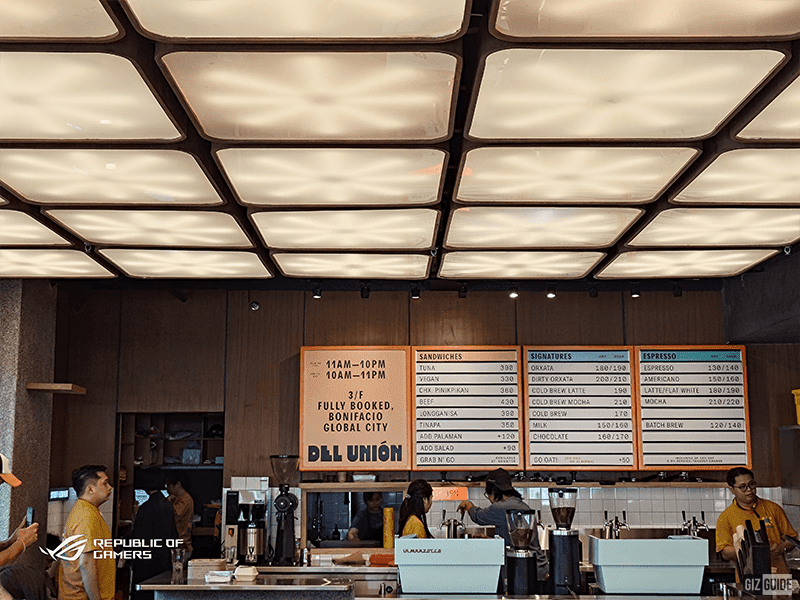 |
Rear camera indoors 3x
|
 |
| Rear camera indoors ultra-wide |
The above images were taken in a well-lit coffee shop. The resulting images from all cameras are good. They are detailed and contrasty with vibrant yet true-to-life colors. Like the daylight images, we have seen sharper results in the price category.
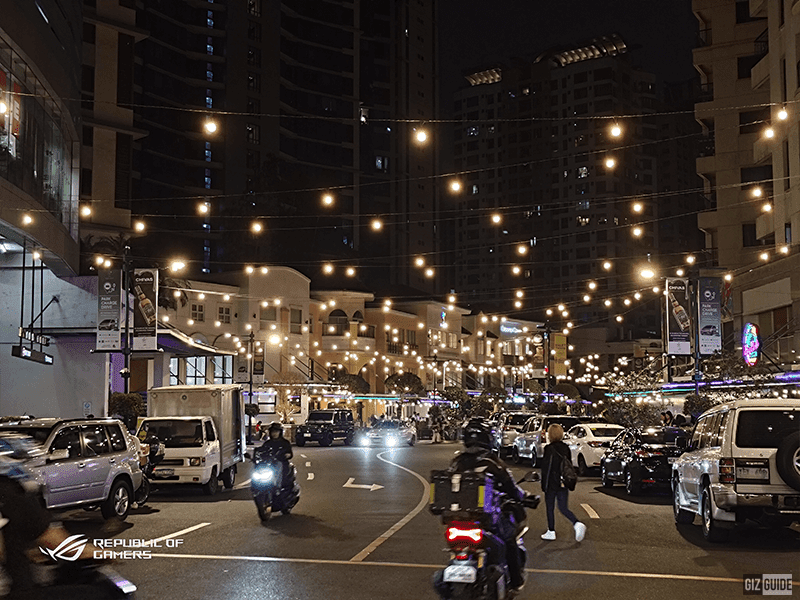 |
| Rear camera low light 2x |
 |
| Rear camera low light 3x |
 |
| Rear camera low light ultra-wide |
In low light, there is minimal noise from the 1x, 2x, and ultra-wide. The images retained the color, contrast, and detail in daylight with almost negligible loss in sharpness. The 3x telephoto has more noticeable noise which causes the noise reduction to reduce some of the sharpness and detail. Otherwise, the 3x is good too.
 |
| Rear camera night mode 1x |
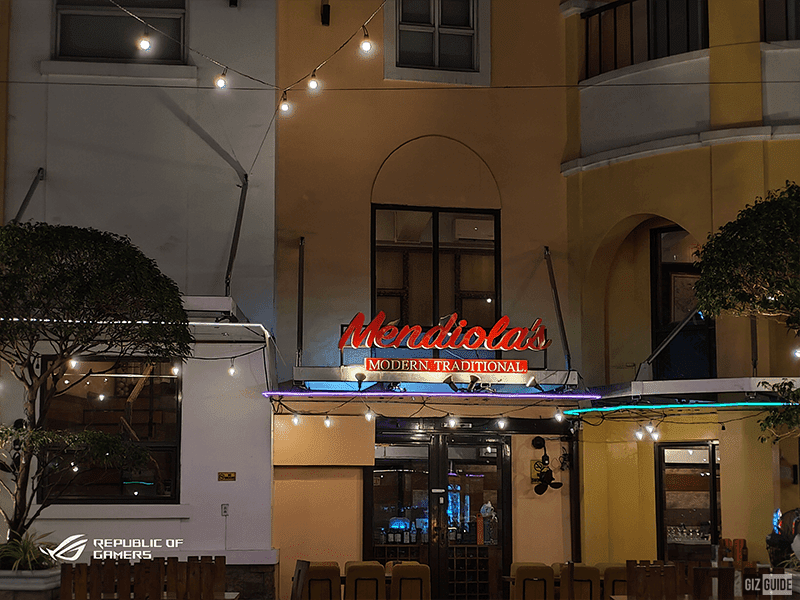 |
| Rear camera night mode 2x |
 |
| Rear camera night mode ultra-wide |
The Night mode removes any sign of noise from all three cameras. The results are sharper and more detailed images with vibrant colors and good contrast. Our only gripe is the ultra-wide images tended to be brighter than the rest of the images. A quick software tweak can fix this and make the images more consistent.
 |
| ROG Phone 8's front-facing cameras |
The 32MP f/2.5 selfie camera with RGBW sensor.
Camera modes include Photo, Video, Portrait, and Night.
Selfie Camera Samples
 |
| Selfie camera daylight |
 |
| Selfie camera portrait |
Daylight selfies from the ROG Phone are good. The image are vibrant and the contrast is strong but the skin tone is not quite right. The image is sharp enough but there are sharper selfie shooters in this price range.
The portrait mode's edge detection worked the majority of the time but did struggle with some fine fibres.
 |
| Selfie camera indoors |
Indoors, the image is similar to daylight where the colors are vibrant and the contrast is deep. But it isn't the sharpest selfie we've seen nor does the skin tone look right.
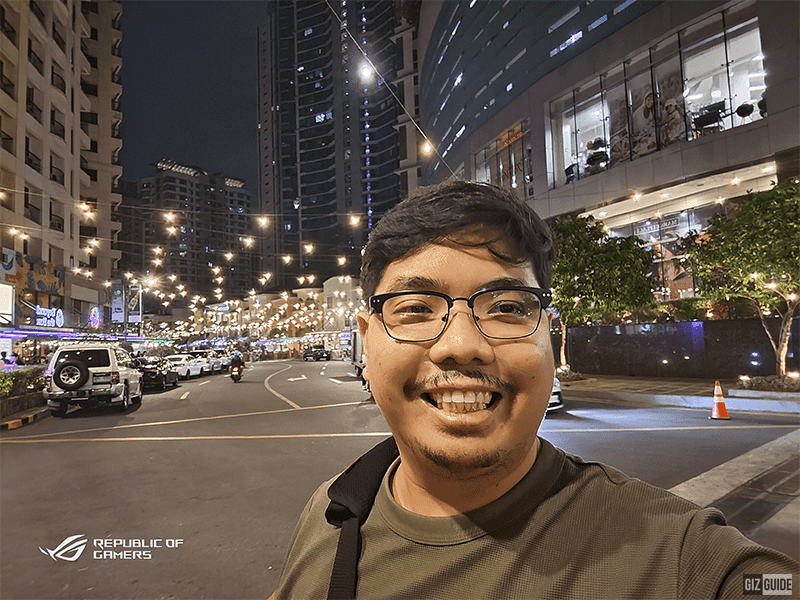 |
| Selfie low light |
 |
| Selfie Night mode |
In low light, the selfie camera's images have increased noise, loss of sharpness, and loss of color accuracy. The night mode improves these flaws significantly and we recommend using the night selfie when possible. One nitpick with the selfie camera is the sun stars made are awkward.
Overall, the front cameras produce images with very good color, contrast, and detail but struggle with skin tones. The images are sharp but given the price range, there are sharper selfie images.
The rear camera can record up to 8K at 24fps with OIS. The footage is sharp and detailed with vibrant color and good contrast. The OIS does its job but we've seen more stable footage.
Performance
 |
| AnTuTu and GeekBench results |
To recap, the ROG Phone 8 features the 3.3GHz 4nm Qualcomm Snapdragon 8 Gen 3 octa-core processor, New Adreno GPU, LPDDR5X, and UFS 4.0.
 |
| 3DMark and CPDT benchmark results |
ROG Phone 8 benchmarks:
- AnTuTu - 2,116,314
- Geekbench 6 - 2,302 (single-core), 7,275 (multi-core)
- 3D Mark WildLife - 5,212 at 31.21 average fps
- CPDT - 657.79 MB/s sequential read speeds and 1.13 GB/s sequential write speeds
The ROG Phone 8 Pro scores in AnTuTu, Geekbench, and 3DMark are at the bleeding edge of what smartphones from late 2023 and early 2024 can do. With a score of more than 2 million on AnTuTu, there are not many apps that can cause this phone to struggle.
According to CPDT, the ROG Phone 8 Pro's UFS 4.0 write speeds are going up to 1.13GB/s while the read speeds are just above half of that. These are still fast read speeds but it could be faster. But honestly, this is a nitpick, 600+MB/s is more than good enough.
 |
| Call of Duty: Mobile Graphics settings |
 |
| Call of Duty: Warzone Graphics settings |
 |
| Genshin Impact Graphics Settings |
 |
| Punishing Gray Raven Graphics settings |
On difficult games like Genshin Impact, it is set on the medium graphics settings as the default. That has been the setting most gaming phones have been on Genshin Impact for years. On more recent games like Call of Duty: Warzone, it unlocked high graphics settings with priority to frame rate.
Playing the game is buttery smooth when wandering around the world and rarely struggle during combat. The incredible sustained performance is attributed to the 360-degree SoC cooling System Gen 2 which uses a rapid cooling conductor between the Soc and the metal near the back cover allowing for fast heat dissipation. It is made with several layers of the following: graphite sheets, a rapid-cooling conductor, boron nitride, and a vapor chamber.
When paired with the AeroActive X Cooler, this sophisticated cooling system allows us to play demanding games almost indefinitely when plugged into the wall charger via USB-C. Without the AeroActive X cooler, we would notice the phone warming up after 30 minutes of gameplay or when downloading massive game files over WiFi. It never got alarmingly hot though.
The cooler also adds additional triggers that can be mapped with the Armory Crate app. This is in addition to the two Air Triggers on top of the phone. All in all, the additional triggers do give a competitive advantage to most games as it makes it easier to press on-screen buttons with triggers as pressing the triggers instead of the screen doesn't block the vision or field of view.
In our experience, the phone can handle all tasks like navigating through the OS, opening apps, web surfing, and social media without struggling.
Fast In-Display fingerprint sensor
For security, the phone has an optical In-Display fingerprint sensor and face unlock. The initial setup and subsequent uses are quick and it detects our biometrics instantaneously. It works even if your finger is a little sweaty or dirty.
The face unlocks only struggles when the camera is dirty. The screen brightens up when used in the dark. It even has a super bright mode when using face unlock that can be set in the settings.
Regarding connectivity, we have the following: WiFi 7, 5G, 4G LTE, Bluetooth 5.3, OTG, GPS, and dual nano SIM.
Connection is usually stable for WiFi and we get 4 to 5 bars of mobile data signal the majority of the time. Its antenna design probably has something to do with this.
 |
| Battery Benchmark results |
Inside the phone is a large 5,500mAh battery which consistently yielded 5 to 6 hours of on-screen time while being our main device that is constantly connected to 5G, LTE, and WiFi. We even use it as our WiFi Hotspot almost every day.
All day battery despite its slim design!
The battery charges via USB-C with the 65W wall charger which charges the phone 100 percent in around 60 minutes.
 |
| ROG Phone 8's Home screen and app drawer |
It is running on ROG UI/Zen UI based on Android 14. Like previous generations, it has all the visuals you would expect from either ROG or Zen UIs that have been updated for modern looks while adding the Android 14 features.
 |
| Initial Start-up UI preference |
However, If you didn't like the older ROG UI or Zen UI, odds are you still won't like this one. But if you're a fan of it, you will more likely enjoy the experience.
Armory Crate has been updated and is pre-installed. More customization and settings have been added for gaming, AniMe Vision controls, and more.
Pros - Premium design and build, 165Hz 1080p Samsung screen, bleeding edge specs, powerful and sophisticated 360-degree cooling system, 15W wireless charging, better than ever rear camera performance, AirTriggers add competitive advantage, AniMe Vision display both cool and useful, AeroActive Cooler X comes in box
Cons - Selfie cameras struggle with skin tones, a slightly lower battery capacity, front-facing speakers from the previous gen were better
ROG Phone 8 and 8 Pro Specs
Display: Gorilla Glass Victus 2 protected 6.78-inch Samsung E6 LTPO AMOLED screen w/ 1-165Hz refreshrate, FHD+ 2400 x 1080 resolution at 388 ppi
CPU: 3.3GHz Qualcomm Snapdragon 8 Gen 3 octa-core processor
GPU: New-Adreno
RAM: 12GB/16GB/24GB LPDDR5X
ROM: 256GB/512GB/1TB UFS 4.0
Back Camera: 50MP f/1.9 1/1.56-inch Sony IMX890 w/ OIS + 13MP f/2.2 120-degree ultra-wide + 5MP macro or 32MP f/2.4 3x telephoto camera with OIS (Pro) + LED flashSelfie Camera: 32MP f/2.5 RGBW
Battery: 5,500mAh w/ 65W fast charging, 15W wireless charging
OS: Android 14 w/ ROG UI, Zen UI
Connectivity: WiFi 7 (2.4GHz/5Ghz), 5G, 4G LTE, Bluetooth 5.3, OTG, GPS, NFC, dual SIM (nano)
Sensors: Accelerometer, light, orientation, proximity, gyroscope, sound, magnetic
Others: In-Display fingerprint sensor, stereo speakers, IP54, AeroActive Portal, cooling system, USB-C, Colors: Phantom Black, Rebel Grey
Dimensions: 163.8 x 76.8 x 8.9 mm
Weight: 225 g
Price: PHP 50,999 (12GB/256GB), PHP 60,995 (16GB/512GB), PHP 74,995 (24GB/1TB)
Verdict
 |
| ROG Phone 8 web surfing experience |
The ROG Phone 8 Pro is the best phone from ASUS and ROG yet!
Aside from being one of the best-performing phones in terms of processing and graphics power, it has a super sleek and sexy design while offering one of the better cameras from the brand yet.
Let's not forget the stunning FHD+ 165Hz Samsung panel and the powerful stereo speakers.
The camera performance is a dramatic improvement from previous generations and can stand toe-to-toe with modern flagships. Although we feel that a few tweaks are still needed.
Although the battery is down to 5,500mAh, it retains the fast and reliable 65W fast charging and the 5 to 6-hour on-screen time. It will have significantly less battery life when gaming all day.
The addition of gaming-focused features such as the Armory Crate software, AirTriggers, and AeroActive X cooler add to the gaming experience and sometimes add a bit of competitive advantage.
The AniMe Vision display is also cool and has some visual yet functional features that add to the overall experience.
We highly recommend the ROG Phone 8 Pro for people who want the best possible processing and graphics power in a sleek and sexy package that can also deliver in the camera category.
You don't even need to get the ROG Phone 8 Pro to get access to the majority of its features and performance, if you can live without the telephoto camera, AniMe Vision display, and smaller memory and storage, you can save money and get the vanilla ROG Phone 8.
What do you think guys?
Build/Design - 4.5
Multimedia Experience - 4.5
Cameras - 4.5
Performance - 4.75
Average - 4.56/5

.gif)





















































Post a Comment